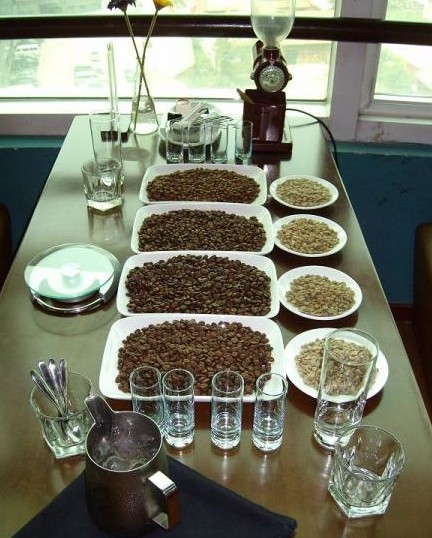The way coffee beans are treated after picking.
Every winter (dry season) is the harvest time for coffee beans. After three to four years of growth, coffee trees mature and begin to bear fruit. The fruits are arranged in a string or clustered together next to the branches. Coffee beans are wrapped in red skins and can be picked as soon as they turn red.

Most Arabica coffee beans mature from June to August and Roberts coffee beans from September to October. Therefore, although in some countries where the dry and wet seasons are not obvious, such as Colombia and Kenya, there are two flowering periods a year, that is, two harvests, strictly speaking, only once a year.
Of course, the harvest time varies from region to region. To the south of the equator, such as Brazil and Zimbabwe, the main harvest is in April or May, but it lasts until August. Regions north of the equator (such as Ethiopia and Central America) are generally harvested in September-November. However, equatorial countries, such as Uganda and Colombia, can harvest all year round, especially those plantations that make good use of different elevations. As a result, there may be new coffee beans for most of the year.
As far as picking coffee beans is concerned, there are two ways. One is picking in pieces, that is, picking all the beans in the garden at once, and the other is picking selectively, that is, picking only the ripe red berries at intervals of 8-10 days, so you need to pick more times in the yard. Compared with the former method, the latter method is labor-intensive and expensive, and is generally used only for Arabica coffee beans, especially those that need to be washed.
The number of coffee beans picked depends on a variety of factors, the most obvious being the height of the trees and the layout of the farm or plantation. On average, the average farm picker can pick 50-100 kilograms a day. However, only 20% of these coffee beans are real coffee beans, so each picker can only pick 10-20 kilograms of coffee beans on average. Coffee beans are packed in bags with a standard mass of 45-60 kilograms. As a result, it takes 3-6 days for a worker to fill a bag.
It has been calculated that the cost of harvesting a plantation or farm is half of the total cost of the year. In Brazil, people have tried many times to use mechanical picking to reduce these costs. The machine shakes branches across the coffee tree so that berries that become loose because they are ripe will fall into the funnel star. But this can only be done in places where natural conditions are better, and they need to be high-speed in advance, because the machine can only be used where the trees can be planted in rows and rows, and the coffee beans picked by the machine need to be checked afterwards to pick out the leaves and branches that have fallen in the funnel. It is troublesome to pick in this way.
In areas with relatively high elevations, such mechanical picking method cannot be adopted, and manual picking must be used, which requires a large number of seasonal workers. Pickers should also be careful not to pick unripe, bad or overripe coffee beans, as they will affect the overall quality of the coffee harvested. The original picking method ensures the quality of coffee bean picking to a great extent. Those coffee beans that are not so good are classified as "ordinary", "sour" or "fermented", and the last one is very bad.
Important Notice :
前街咖啡 FrontStreet Coffee has moved to new addredd:
FrontStreet Coffee Address: 315,Donghua East Road,GuangZhou
Tel:020 38364473
- Prev

Become a coffee expert in 3 minutes. Learn to make the most famous kinds of coffee all over the world.
There are unique features of making coffee drinks all over the world, and each has its own characteristics. It seems very complicated and difficult to make, but it is actually very simple. Teach you to quickly master the skills of specialty coffee from all over the world! From then on, he immediately turned into a coffee master and didn't go out of the house to drink coffee all over the world! The practice of using a short 3 minutes to show the world's different flavors of coffee, there are heavy mouths, there are
- Next

Significance of cupping Coffee Cup Test Fine Coffee Technology
The significance of cup test is to evaluate and compare several different kinds of coffee at the same level. Because the differences between coffees are very subtle, observe the characteristics of these coffees (flavor, mellow, freshness.) It is easily affected by different coffee extraction methods (utensils). Because of the elimination of these variables, carefully prepared cup tests can taste the most basic inherent characteristics of coffee.
Related
- What is the meaning of lactic acid fermentation with coffee bean treatment?
- How to judge the state of foam by sound?
- How does the latte pull out the unicorn pattern? Come to get for a little trick to improve the flower pull!
- Will flower pulling affect the taste of the latte?
- Do you know the history of coffee?
- The difference between honey treatment and sun washing what is raisin honey treatment?
- What kind of milk can a novice use to make coffee foam to keep the foam longer? The correct method and skills of milking tutorial sharing
- Why do washed coffee beans taste sour? Flavor characteristics of washed Coffee
- Introduction to the skill of how to practice the size and height of water injection around the circle of hand-brewed coffee
- How do beginners practice coffee flower drawing from scratch?

